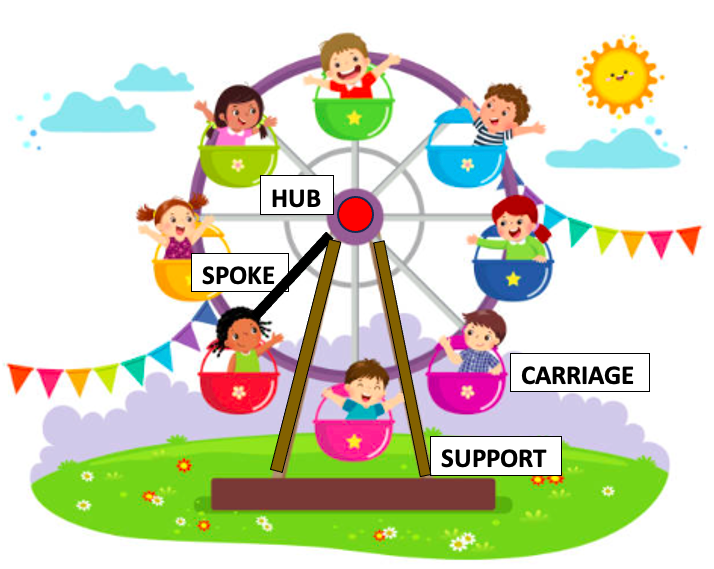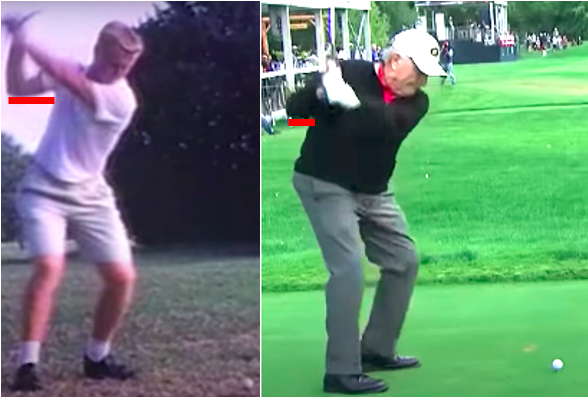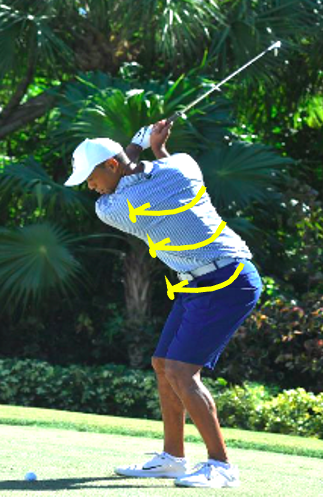When Common Sense Derails in Pursuit of Ever-Crazier Golf Swing Movements
The Four (for now) Exhibits of Utter Madness
Imagine, for a moment, that you are enjoying a carefree ride on a ferris-wheel. How would you feel, locked up in a carriage if it was shaken up and down and side to side as the support system of the ferris wheel moved violently about? Might you have concerns?

What if the hub of the ferris-wheel were to drop as you started your ride and then lift as you had to get off? Would you worry about being able to get off your carriage when it reached its lowest point and it was your turn to alight from it? What if it did not return to the exact spot it started from, as a result of all the lifting and dropping? You might either crash into the ground if it did not lift back up enough, or you might have to jump 6 feet off the carriage to reach terra firma if it lifted too much!

This, folks, is Exhibit 1 in golf-swing foolishness. If you consider the lead (left, for a right-handed golfer) shoulder to be the hub of the swing, would it not make sense for it to remain in place so that the ‘carriage’ – the clubhead – could return precisely to the spot it started from (near the ball which is on the ground)?
Consider your head, torso and legs to be the support system of the ferris-wheel and STOP MOVING THEM! It upsets dynamic balance and it requires large, slow-moving, poorly innervated body parts to move at the “speed of lightening”. So that you can undo all your backswing movements during the fraction of a second that the downswing lasts! Most importantly, if your lead shoulder is higher than the trail one at address and at impact, what earthly sense does it make to drop it (along with your lead hip and lead knee) lower at the top of the backswing?
This movement is merely an artifact that has been passed on to us unchallenged, since the shepherds of Scotland first started playing some version of golf. It is simply a natural result of lifting the arms. However, it IS possible to lift the arms without lifting the trail side of the body, as I have discovered from 30 years of swing research.
Exhibit 2 is torso rotation. Either the rotation of both shoulder and pelvis together as in the ‘classic’ swing or maximal torso with minimal pelvis rotation as in the ‘modern’ swing. The first does not generate as much speed as the second, and the second, as seen through research, could be prone to causing injury (an important paper on the subject: https://www.redalyc.org/pdf/710/71041205.pdf ). It is my belief that golfers’ arms swings narrow because of excessive torso rotation as they age and can no longer sustain extended arms at the top from reduced strength (see pictures of Jack Nicklaus below). That need not be the case with swing-modifications, however!

The golf swing does NOT need torso rotation to create greater speed. How can that be, you ask – it seems sacrilegious to say such a thing! Generations of golfers have coiled/twisted/torqued the torso! What is actually required is a good width of the trail arm so the pecs and lats of that side stretch and can contract forcefully at the start of the downswing, followed by the serratus anterior and the external obliques of the same side contracting. [My class-project EMG paper available upon request via the contact form on this website]. Incidentally, reduced rotation will also reduce low back injury risk.
Dr. Stuart McGill, famous biomechanist, discovered through 15 years of researching golf swings that there is a small pulse of force from the trail side butt muscle (gluteus maximus) just before impact, and a small pulse of the trail side abdominal muscle (external oblique) at impact. If that is all that is required, why make all that rotation of so many individual vertebrae all being moved through different ranges of motion during the backswing, but requiring to move together as a single unit during the limited time of the downswing? [The creases in the shirt in the picture below clearly indicate how different levels of the spine have been moved through different ranges of motion].

Additionally, McGill is famous for his concept of ‘proximal stiffness for distal speed’. For instance, when a boxer wishes to land a powerful punch, he does not move his entire body, but simply his punching arm, against a very still body.

And, on the subject of ‘proximal’ (which, for the human body, is approximately the center of the torso) stiffness, which one might translate to also incorporate stillness: the golfer should use the stillness of the legs and pelvis against which to forcefully move the arms and not be moving the entire body and hoping for a precise ‘punch’ to be landed on the ball by the clubhead – at precisely the right place.
That, ladies and gentlemen, brings us to Exhibit 3 of utter golf-swing madness. One single research study based on observational research only, has resulted in golfers trying to create large ‘moment arms’ between the center of mass of the body and the center of pressure. All in a copy-paste manner. No questions have been asked. For instance, what is the ideal magnitude of such a ‘moment arm’? Can a person put a lot of pressure through one foot while hanging back with the body’s mass to create the large moment arm (pressure = force/area and force needs more mass)? Are golfers who are seeing greater speed while performing this movement seeing it BECAUSE OF or DESPITE the added body movements? Of course the added momentum generated by so many rapidly moving body parts will generate greater club speed, but is it suitably and consistently being applied to the ball as well as to the correct part of the ball?
And thus on to Exhibit 4. Golfers during the past few years are being told to move about excessively in the name of Newton. Specifically his Third. In which he told us that to every action there is an equal and opposite reaction. So, you are told, if you shift pressure to the trail side, the ground will push back on you and move you forward.
Then, as you start the downswing, you have to push your lead leg and knee (knee injury anyone?) down and forwards (towards target) and the ground will push up and make you taller, make your lead arm and shaft ‘longer’ in time for impact, which would result in a longer lever and thus greater club speed.

Oh and I forgot to mention that although golfers are told to shift back away from target at the start of the backswing, by the top it has to be centered again – why bother to shift, in that case?
Here’s a simple experiment to explain the role of the ground (often referred to as ground reaction force) in movement. Lean one hand against a wall then push against the wall as hard as you possibly can. Did you simply fly off the wall or did you remain exactly where you were? Basically, one uses the ground or any firm surface like the wall just to get ‘purchase’ off (a key term that all golfers should understand the meaning of – when it does not refer to buying something!). The surface is merely a passive entity, offering RESISTANCE for one’s muscles to contract forcefully off of.
Golfers, I implore you to use common sense to understand how injurious the currently taught golf swing – in all its thousands of permutations and combinations – is to your golf health. From both a performance and an injury perspective. Do you notice that certain movements come into, and go out of, fashion? Are you a willing part of the golf ‘fashion’ industry?
I can help you improve with no force plates, no motion capture and no sophisticated launch monitor (after all, your eyes can see directional failures and a simple gadget that tells you club/ball speed is all you need).
How can I help? By giving you precise – and limited – steps for the set-up and the backswing that will give you the ideal thought-free downswing. Your top-of-backswing positions will ensure that your desired ‘magic moves’ (shallower club, inside path, long arm-shaft lever with tall lead side etc. etc.) all happen automatically without the need for conscious thought. And the bad moves like unreliable clubface aim at impact or over-the-top, or early extension, in the downswing never do.
I am able to do this only because I have moved way past the biomechanics of the swing and have a clear understanding of the anatomy of the human body and its joint capabilities. Also, I have spent time understanding more about motor control and how certain positions at the top will make the body move in a certain way (both good and bad).
So, for those keen on self-inflicted torture, soldier on with the ‘typical’ golf swing. Or, save yourself, your sanity, your performance, and your body, and learn the precise steps to consistently better golf.
And, by the way, check out the testimonial from Mike Stupple of the UK who had simply watched some of my videos on YouTube (the entire collection may be seen elsewhere on this website) and not even read my ebook (available free of cost, also elsewhere on this website) and after a single online lesson (something I typically avoid) improved exponentially and continues to do so.


